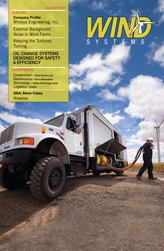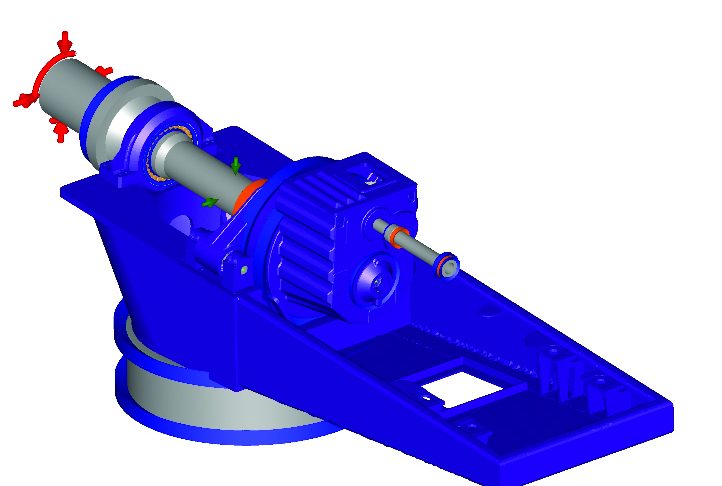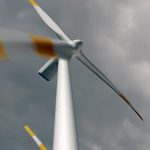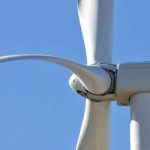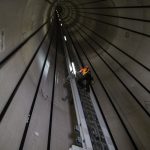While onshore wind energy has been the world’s fastest growing energy source for more than a decade, there is an increasing interest in using offshore wind turbines especially in deep water. The interest is mainly because of higher and more consistent wind speed offshore: no size limitation on the blade size due to the road and rail constraints; no visual and noise annoyance; more possible places for installation; and high potential for offshore wind energy extraction in the U.S.
Despite their great potential, there is no functional floating wind turbine in the world (apart from a few experimental ones), as there are yet many fundamental studies necessary before they can be realized. Among the most critical studies needed for the offshore floating wind turbines are studies on fluid-structure interactions.
When a structure is in contact with flow, it could deform or oscillate due to the fluid forces. The deformation or oscillation of the structure results in changes in the fluid forces, leading to new deformation of the structure. This is a fluid-structure interaction case.
In a floating wind turbine, many cases of fluid-structure interactions are observed. Large wind turbine blades, which are common for the offshore wind turbines, are susceptible to various flow-induced dynamical instabilities. This means that if the blades are too large, or too flexible, they can undergo large-amplitude oscillations in a plane perpendicular to the plane of rotation. The result is that the blade will break immediately, or will hit the tower. The blades are attached to a tower, which oscillates due to the interaction of the platform with the ocean waves. The entire floating wind turbine is supported by mooring lines, which can undergo vortex-induced vibrations (VIV). These are oscillations with amplitudes of the order of one cable diameter and a rather low frequency (usually ranging from around 1 Hz to around 10 Hz). Although its amplitudes and frequencies are not very large, VIV is a major concern, as it can lead to fatigue and failure of the mooring lines. A failed mooring system results in a floating wind turbine moving freely in the ocean – a situation that should definitely be avoided.
At the Fluid-Structure Interactions lab of University of Massachusetts, we study the fluid-structure interaction systems involved in floating offshore wind turbines, theoretically and experimentally.
The theoretical component of our work is based on analytical modeling of nonlinear fluid-structure interaction systems. For example, we are working on a nonlinear model to predict possible dynamical instabilities of large wind turbine blades. These models are coupled nonlinear partial differential equations, which are reduced to a set of ordinary differential equations using the Galerkin technique, and then solved using Houbolt’s finite difference method. The results will give us the critical wind speeds for dynamic instabilities of wind turbine blades.
At the UMass FSI lab, we have a recirculating water tunnel with a test-section of 38 cm × 50 cm × 150 cm and a maximum flow rate of 1.0 m/s. We use this tunnel for the experimental components of our studies. We conduct tests to investigate the vortex-induced vibrations of a flexible cylinder placed in flow with various angles of inclination. In a floating offshore wind turbine, the mooring lines could be placed perpendicularly to the oncoming flow, and in some cases, with an angle with respect to the flow. We study experimentally the influence of this angle of inclination on the resulting VIV response.
In our open-section wind tunnel (operated by the UMass Wind Energy Center, in conjunction with the Mechanical and Industrial Engineering Department), we conduct experiments on small-scale wind turbine blades to study their instability. The wind tunnel has a cross-section of 1.0 m × 1.0 m and the maximum wind speed is 18 m/s. The goal is to quantify the onset of possible instabilities for flexible blades, with various designs. Increasing the wind speed from zero to the maximum, we measure the tip displacements of the wind turbine blades to see if any dynamic instability can occur. The results will help us validate our theoretical model for blade instability and to be able to predict the onset of instability for larger blades.
This is a summary of various ongoing FSI projects related to the offshore floating wind turbines. In future columns, I will give more details about the problems I have discussed here.
















